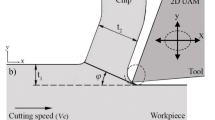Abstract
The paper presents a novel approach for modelling and simulation of the surface generation in the machining process. The approach, by integrating a dynamic cutting force model, regenerative vibration model, machining system response model and tool profile model, models the complex surface generation process. Matlab Simulink is used to interactively perform the simulation in a user-friendly, effective and efficient manner. The effects of machining variables and tooling characteristics on the surface generation are investigated through simulations. CNC turning trials have been carried out to evaluate and validate the approach and simulations presented. The proposed approach contributes to comprehensive and better understanding of the machining system, and is promising for industrial applications with particular reference to the optimisation of the machining process based on the product/component surface functionality requirements.
Similar content being viewed by others
References
Taraman K, Lambert B (1974) A surface roughness model for a turning operation. Int J Prod Res 12(6):691–703
Whitehouse DJ (1994) Handbook of surface metrology. Institute of Physics Publishing, Bristol
Moriwaki T, Sugimura N, Luan S (1993) Combined stress, material flow and analysis of orthogonal micromachining of Copper. Ann CIRP 42(1):75–78
Baras JS, Patel NS (1996) Designing response surface model-based run-by-run controllers: a worst case approach. IEEE Trans Components, Packaging & Manuf Technol, Part C Manuf 19(2):98–104
Iain RK, Jain VK (2000) Optimum selection of machining conditions in abrasive flow machining using neural network. J Mater Process Technol 108(1):62–67
Altintas Y (2000) Manufacturing automation: metal cutting mechanics, machine tool vibrations, and CNC design. Cambridge University Press, Cambridge
Cheung CF, Lee WB (2001) Characterisation of nanosurface generation in single-point diamond turning. Int J Mach Tools Manuf 41:851–875
Arcona C, Dow TA (1998) An empirical tool force model for precision machining. Trans ASME: J Manuf Sci Eng 120:700–707
Fan X, Miller MH (2002) The application of an empirical tool force model on vibration cutting. Proceedings, 17th ASPE Annual Meeting, St Louis, USA, pp 484–489, 20–25 October
Armarego EJA, Brown RH (1969) The machining of metals. Prentice-Hall, Englewood Cliff, NJ
Shaw MC (1984) Metal cutting principles. Oxford University Press, Oxford
Komanduri R, Chandrasekaran N, Raff LM (1998) Effect of tool geometry in nanometric cutting: a molecular dynamics simulation approach. Wear 219:84–97
Luo XK, Cheng K, Luo XC (2003) A simulated investigation on machining instability and non-linear aspects in CNC tuning processes. Int J Manuf Sci Prod 5(1–2):45–50
Cheng K, Luo XC, Luo XK (2003) A simulated investigation on the surface functionalities in precision machining processes. Proceedings, 18th International Conference on Computer-Aided Production Engineering (CAPE 2003), Edinburgh, UK, pp 385–394, 18–19 March
Author information
Authors and Affiliations
Corresponding author
Rights and permissions
About this article
Cite this article
Luo, X., Cheng, K. & Ward, R. The effects of machining process variables and tooling characterisation on the surface generation. Int J Adv Manuf Technol 25, 1089–1097 (2005). https://doi.org/10.1007/s00170-003-1943-0
Received:
Accepted:
Published:
Issue Date:
DOI: https://doi.org/10.1007/s00170-003-1943-0




